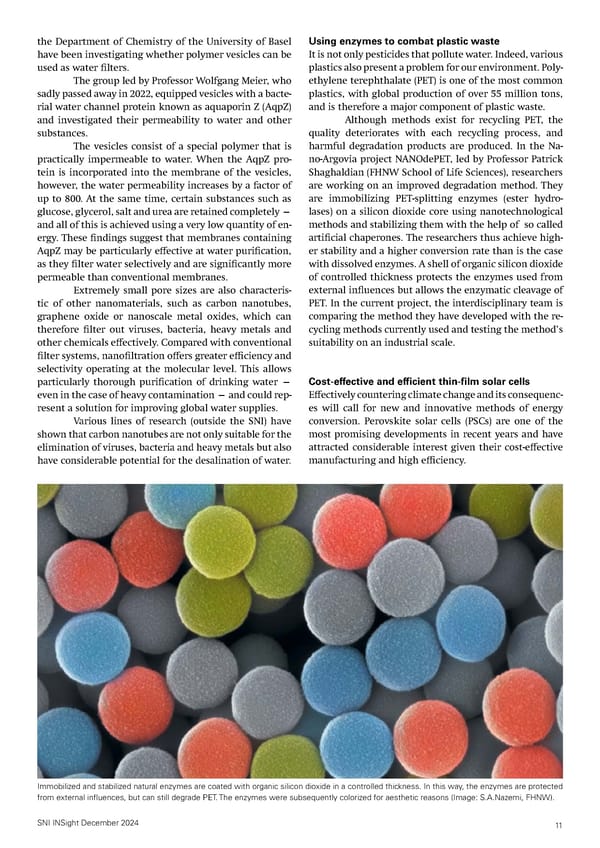the Department of Chemistry of the University of Basel Using enzymes to combat plastic waste have been investigating whether polymer vesicles can be It is not only pesticides that pollute water. Indeed, various used as water 昀椀lters. plastics also present a problem for our environment. Poly- The group led by Professor Wolfgang Meier, who ethylene terephthalate (PET) is one of the most common sadly passed away in 2022, equipped vesicles with a bacte- plastics, with global production of over 55 million tons, rial water channel protein known as aquaporin Z (AqpZ) and is therefore a major component of plastic waste. and investigated their permeability to water and other Although methods exist for recycling PET, the substances. quality deteriorates with each recycling process, and The vesicles consist of a special polymer that is harmful degradation products are produced. In the Na- practically impermeable to water. When the AqpZ pro- no-Argovia project NANOdePET, led by Professor Patrick tein is incorporated into the membrane of the vesicles, Shaghaldian (FHNW School of Life Sciences), researchers however, the water permeability increases by a factor of are working on an improved degradation method. They up to 800. At the same time, certain substances such as are immobilizing PET-splitting enzymes (ester hydro- glucose, glycerol, salt and urea are retained completely — lases) on a silicon dioxide core using nanotechnological and all of this is achieved using a very low quantity of en- methods and stabilizing them with the help of so called ergy. These 昀椀ndings suggest that membranes containing arti昀椀cial chaperones. The researchers thus achieve high- AqpZ may be particularly e昀昀ective at water puri昀椀cation, er stability and a higher conversion rate than is the case as they 昀椀lter water selectively and are signi昀椀cantly more with dissolved enzymes. A shell of organic silicon dioxide permeable than conventional membranes. of controlled thickness protects the enzymes used from Extremely small pore sizes are also characteris- external in昀氀uences but allows the enzymatic cleavage of tic of other nanomaterials, such as carbon nanotubes, PET. In the current project, the interdisciplinary team is graphene oxide or nanoscale metal oxides, which can comparing the method they have developed with the re- therefore 昀椀lter out viruses, bacteria, heavy metals and cycling methods currently used and testing the method’s other chemicals e昀昀ectively. Compared with conventional suitability on an industrial scale. 昀椀lter systems, nano昀椀ltration o昀昀ers greater e昀케ciency and selectivity operating at the molecular level. This allows particularly thorough puri昀椀cation of drinking water — Cost-effective and efficient thin-film solar cells even in the case of heavy contamination — and could rep- E昀昀ectively countering climate change and its consequenc- resent a solution for improving global water supplies. es will call for new and innovative methods of energy Various lines of research (outside the SNI) have conversion. Perovskite solar cells (PSCs) are one of the shown that carbon nanotubes are not only suitable for the most promising developments in recent years and have elimination of viruses, bacteria and heavy metals but also attracted considerable interest given their cost-e昀昀ective have considerable potential for the desalination of water. manufacturing and high e昀케ciency. Immobilized and stabilized natural enzymes are coated with organic silicon dioxide in a controlled thickness. In this way, the enzymes are protected from external in昀氀uences, but can still degrade PET. The enzymes were subsequently colorized for aesthetic reasons (Image: S.A.Nazemi, FHNW). SNI INSight December 2024 11
 SNI INSight December 2024 Page 10 Page 12
SNI INSight December 2024 Page 10 Page 12